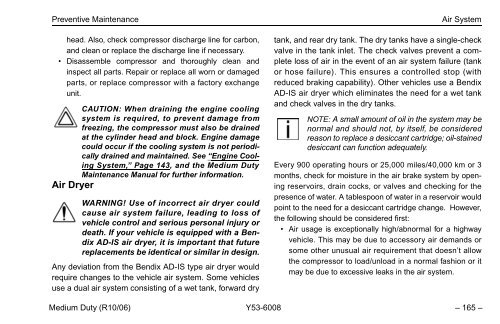Peterbilt Medium Duty Trucks Operator's Manual after 1-07
Peterbilt Medium Duty Trucks Operator's Manual after 1-07
Peterbilt Medium Duty Trucks Operator's Manual after 1-07
Create successful ePaper yourself
Turn your PDF publications into a flip-book with our unique Google optimized e-Paper software.
Preventive Maintenance<br />
head. Also, check compressor discharge line for carbon,<br />
and clean or replace the discharge line if necessary.<br />
• Disassemble compressor and thoroughly clean and<br />
inspect all parts. Repair or replace all worn or damaged<br />
parts, or replace compressor with a factory exchange<br />
unit.<br />
CAUTION: When draining the engine cooling<br />
system is required, to prevent damage from<br />
freezing, the compressor must also be drained<br />
at the cylinder head and block. Engine damage<br />
could occur if the cooling system is not periodically<br />
drained and maintained. See “Engine Cooling<br />
System,” Page 143, and the <strong>Medium</strong> <strong>Duty</strong><br />
Maintenance <strong>Manual</strong> for further information.<br />
Air Dryer<br />
WARNING! Use of incorrect air dryer could<br />
cause air system failure, leading to loss of<br />
vehicle control and serious personal injury or<br />
death. If your vehicle is equipped with a Bendix<br />
AD-IS air dryer, it is important that future<br />
replacements be identical or similar in design.<br />
Any deviation from the Bendix AD-IS type air dryer would<br />
require changes to the vehicle air system. Some vehicles<br />
use a dual air system consisting of a wet tank, forward dry<br />
Air System<br />
tank, and rear dry tank. The dry tanks have a single-check<br />
valve in the tank inlet. The check valves prevent a complete<br />
loss of air in the event of an air system failure (tank<br />
or hose failure). This ensures a controlled stop (with<br />
reduced braking capability). Other vehicles use a Bendix<br />
AD-IS air dryer which eliminates the need for a wet tank<br />
and check valves in the dry tanks.<br />
NOTE: A small amount of oil in the system may be<br />
normal and should not, by itself, be considered<br />
reason to replace a desiccant cartridge; oil-stained<br />
desiccant can function adequately.<br />
Every 900 operating hours or 25,000 miles/40,000 km or 3<br />
months, check for moisture in the air brake system by opening<br />
reservoirs, drain cocks, or valves and checking for the<br />
presence of water. A tablespoon of water in a reservoir would<br />
point to the need for a desiccant cartridge change. However,<br />
the following should be considered first:<br />
• Air usage is exceptionally high/abnormal for a highway<br />
vehicle. This may be due to accessory air demands or<br />
some other unusual air requirement that doesn’t allow<br />
the compressor to load/unload in a normal fashion or it<br />
may be due to excessive leaks in the air system.<br />
<strong>Medium</strong> <strong>Duty</strong> (R10/06) Y53-6008 – 165 –
















